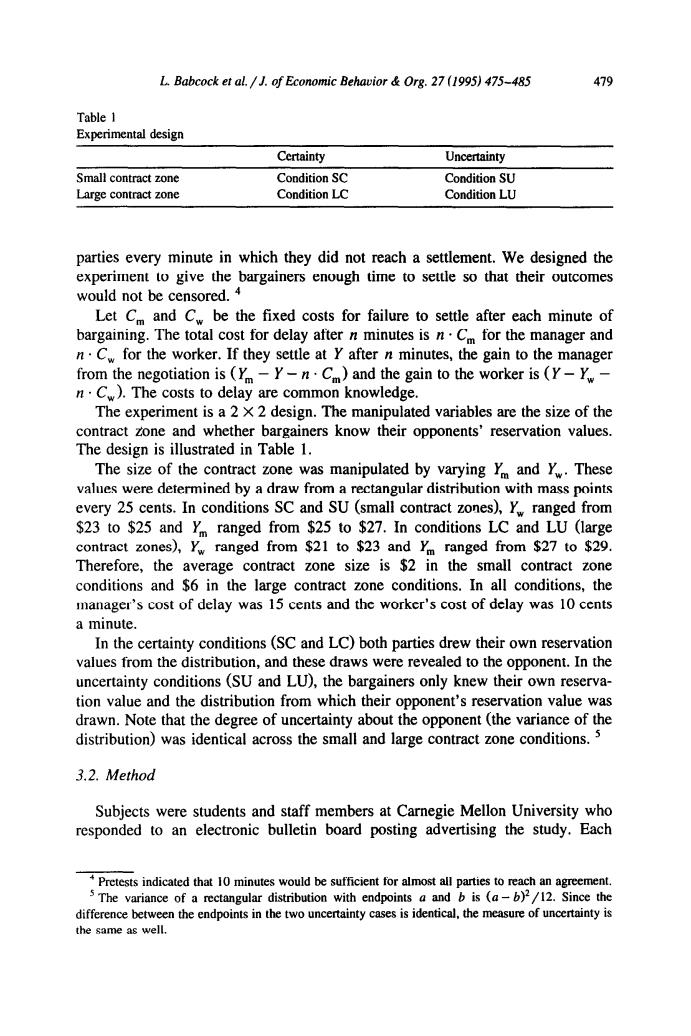正在加载图片...

L.Babcock et al./J.of Economic Behavior Org.27(1995)475-485 479 Table 1 Experimental design Certainty Uncertainty Small contract zone Condition SC Condition SU Large contract zone Condition LC Condition LU parties every minute in which they did not reach a settlement.We designed the experiment to give the bargainers enough time to settle so that their outcomes would not be ensored 4 Let C and C be the fixed costs for failure to settle after each minute of bargaining.The total cost for delay after n minutes is nC for the manager and n.C.for the worker.If they settle at Y after n minutes,the gain to the manager from the negotiation is (Y-Y-n.C)and the gain to the worker is (Y-Y n.C.).The costs to dela are common knowledge The expe is a 2x2 design The mam ulated variables are the size of the contract Zone and whe rgainers know their opponents'reservation values. The design is illustrated in Table 1. The size of the contract zone was manipulated by varying y and y.These values were determined by a draw from a rectangular distribution with mass points y25cents.In conditions SC and SU(small contract)ranged from ranged from to S2 27.In conditions LC and LU (large contract zones),w ranged from $21 to $23 and Ym ranged from $27 to $29 Therefore,the average contract zone size is $2 in the small contract zone conditions and $6 in the large contract zone conditions.In all conditions,the 's cost of delay was 15 cents and the worker's cost of delay was 10 cents a minute In the certainty conditions(SC and LC)both parties drew their own reservation values from the distribution,and these draws were revealed to the opponent.In the uncertainty conditions (SU and LU),the bargainers only knew their own reserva- tion value and the distribution from which their opponent's reservation value was drawn.Note that the ertai ty about th t(the variance of the distribution)was identical across the small and large contract zone conditions 3.2.Method Subjects were students and staff members at Carnegie Mellon University who responded to an electronic bulletin board posting advertising the study.Each utes w ld be sufficien almost a agreem nce o nte in s is id tical.th the same as w velL L. Babcock et al. /J. of Economic Behavior & Org. 27 (1995) 475-485 419 Table 1 Experimental design Small contract zone Large contract zone Certainty Condition SC Condition LC Uncertainty Condition SU Condition LU parties every minute in which they did not reach a settlement. We designed the experiment to give the bargainers enough time to settle so that their outcomes would not be censored. 4 Let C, and C, be the fixed costs for failure to settle after each minute of bargaining. The total cost for delay after n minutes is n * C,,, for the manager and n . C, for the worker. If they settle at Y after n minutes, the gain to the manager from the negotiation is (Y, - Y - n . C,,,) and the gain to the worker is (Y - Y, - n . C,). The costs to delay are common knowledge. The experiment is a 2 X 2 design. The manipulated variables are the size of the contract zone and whether bargainers know their opponents’ reservation values. The design is illustrated in Table 1. The size of the contract zone was manipulated by varying Y, and Y,. These values were determined by a draw from a rectangular distribution with mass points every 25 cents. In conditions SC and SU (small contract zones), Y, ranged from $23 to $25 and Y, ranged from $25 to $27. In conditions LC and LU (large contract zones), Y, ranged from $21 to $23 and Y, ranged from $27 to $29. Therefore, the average contract zone size is $2 in the small contract zone conditions and $6 in the large contract zone conditions. In all conditions, the manager’s cost of delay was 15 cents and the worker’s cost of delay was 10 cents a minute. In the certainty conditions (SC and LC) both parties drew their own reservation values from the distribution, and these draws were revealed to the opponent. In the uncertainty conditions (SU and LU), the bargainers only knew their own reservation value and the distribution from which their opponent’s reservation value was drawn. Note that the degree of uncertainty about the opponent (the variance of the distribution) was identical across the small and large contract zone conditions. 5 3.2. Method Subjects were students and staff members at Carnegie Mellon University who responded to an electronic bulletin board posting advertising the study. Each 4 Pretests indicated that 10 minutes would be sufficient for almost all parties to reach au agreement. 5 The variance of a rectangular distribution with endpoints a and b is (a - b)‘/12. Since the difference between the endpoints in the two uncertainty cases is identical, the measure of uncertainty is the same as well